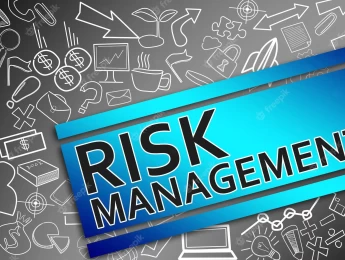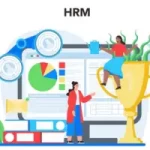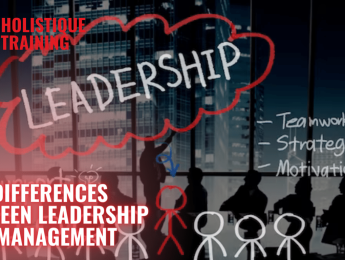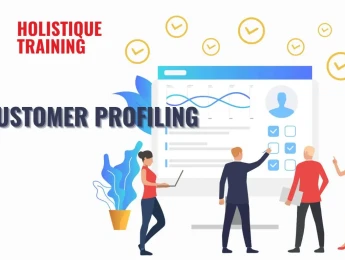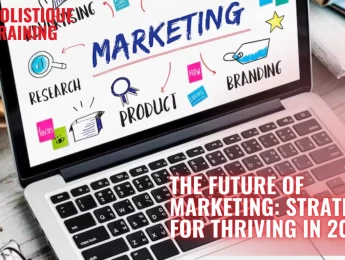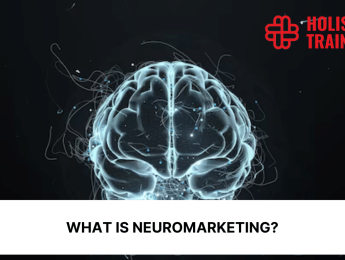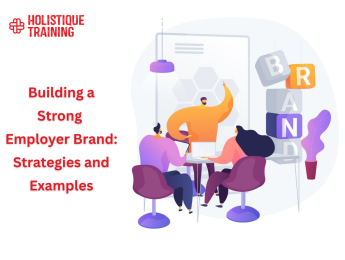- Table of Contents
- Introduction
- What Is HR Risk Management?
- The Significance of Risk Management in HR
- Safeguarding Reputation and Brand Image
- Minimising Financial Impact
- Fostering a Positive Work Culture
- Ensuring Legal Compliance
- Driving Business Continuity
- The Relationship between HR Management and Risk Management
- Applying Risk Management to HR
- Identifying HR Risks
- Assessing and Prioritising Risks
- Mitigating Risks
- Case Study: XYZ Corp's HR Risk Management Success Story
- XYZ Corp's HR Risk Assessment
- Outcomes
- Technology and HR Risk Management
- 1. Advanced Analytics and Predictive Tools
- 2. AI-Driven Recruitment and Selection
- 3. HR Software for Compliance
- 4. Data Security and Privacy
- 5. Employee Monitoring and Feedback Tools
- 6. Learning Management Systems (LMS)
- 7. HR Analytics Dashboards
- 8. Artificial Intelligence in Employee Surveys
- 9. Robotic Process Automation (RPA)
- 10. Blockchain for Secure Record Keeping
- Cultural Sensitivity and Global HR Risk Management
- Cultural Intelligence (CQ) Training
- Diverse Hiring Practices
- Cultural Competency in Policies and Practices
- Conflict Resolution and Mediation
- Cultural Sensitivity Audits
- Cross-Cultural Training for Expatriates
- Diversity and Inclusion Initiatives
- Continuous Feedback and Adaptation
- Legal Compliance Across Borders
- Global HR Communication Strategies
- Conclusion
Introduction
In today's dynamic and ever-evolving business landscape, organisations face numerous challenges in managing their human resources effectively. Human Resources (HR) Risk Management has emerged as a crucial discipline that empowers companies to proactively identify, assess, and mitigate risks associated with their workforce. In this comprehensive exploration of HR Risk Management, we will delve into the concept's intricacies, its profound significance, the symbiotic relationship between HR Management and Risk Management, and practical ways organisations can apply risk management principles to HR practices.
What Is HR Risk Management?
HR Risk Management is a strategic approach that involves identifying, evaluating, and mitigating potential risks related to the workforce and HR practices within an organisation. It encompasses various issues, including compliance with employment laws and regulations, talent acquisition and retention, employee performance and development, workplace safety, and employee relations.
The Significance of Risk Management in HR
Amidst the ever-changing corporate landscape, HR Risk Management has assumed an indispensable role as a strategic tool for organisations. Its multifaceted significance resonates across various dimensions, profoundly impacting the workforce's success and well-being and the company's overall sustainability. Let’s explore some of the benefits of risk management in HR:
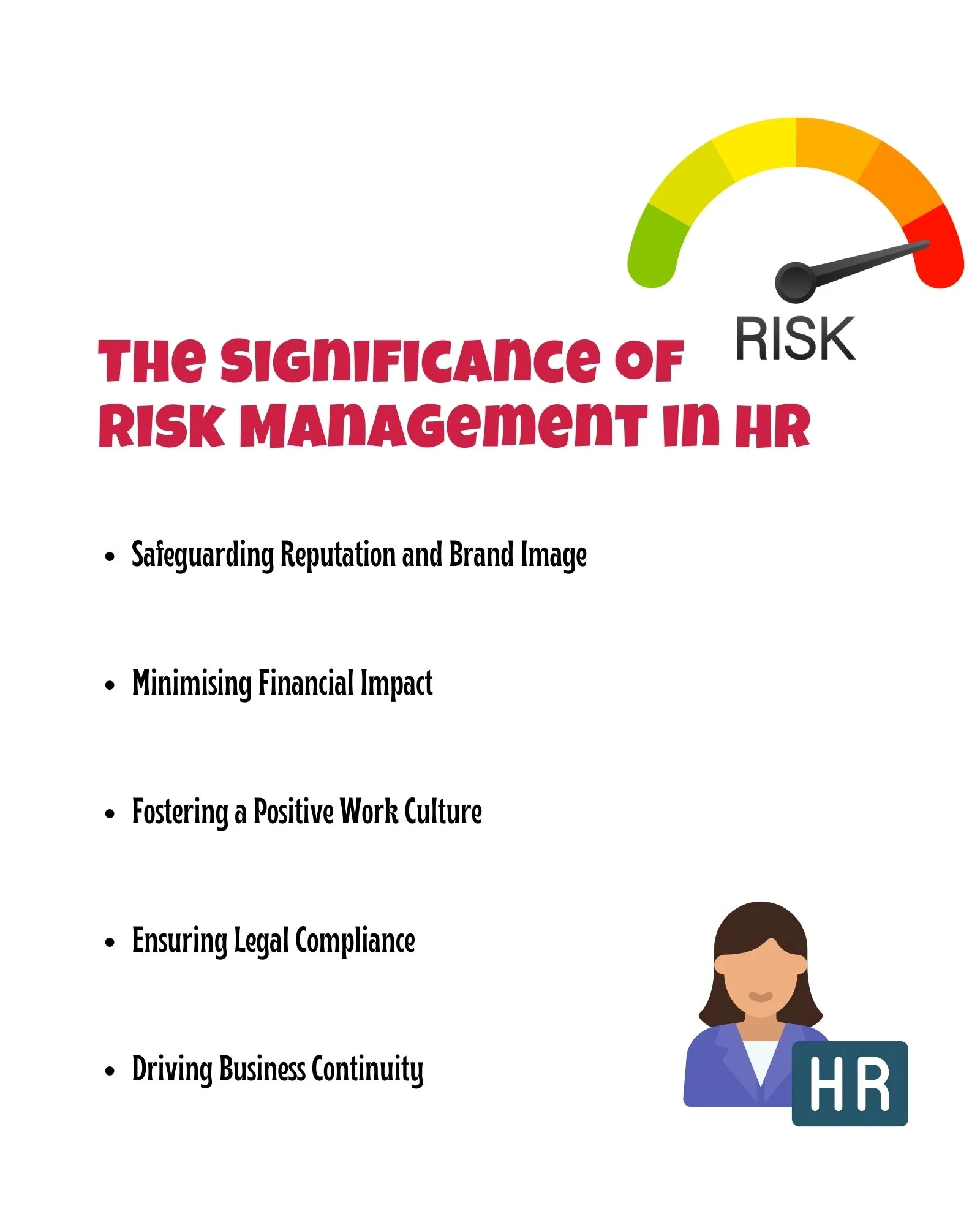
Safeguarding Reputation and Brand Image
In the age of social media and instant communication, a company's reputation can be tarnished in a matter of minutes. HR Risk Management is critical in safeguarding an organisation's reputation and brand image. By identifying and mitigating potential HR-related risks, companies can prevent incidents such as workplace misconduct, discrimination, or safety violations from spiralling into major public relations crises. Ensuring a positive work culture and ethical practices protects a company's brand and enhances its appeal as an employer of choice, attracting top talent and driving long-term success.
Minimising Financial Impact
HR-related liabilities can significantly impact organisations. Lawsuits, fines, and settlements resulting from non-compliance with employment laws or workplace incidents can drain financial resources and negatively affect the bottom line. Organisations can proactively address potential risks through effective HR Risk Management, reducing the likelihood of costly legal battles and financial losses. By investing in risk mitigation strategies, companies save money and create a stable financial environment that fosters growth and innovation.
Fostering a Positive Work Culture
A healthy work culture is the foundation of a thriving organisation. HR Risk Management promotes creating a positive and inclusive work environment, where employees feel valued, safe, and respected. By addressing potential risks, such as discrimination, harassment, or bullying, HR professionals create a workplace where employees can flourish, resulting in increased productivity, reduced turnover, and higher employee satisfaction. A positive work culture also encourages open communication, constructive feedback, and mutual trust, leading to stronger team dynamics and improved overall performance.
Ensuring Legal Compliance
The ever-evolving landscape of employment laws and regulations poses a significant challenge for organisations. Failure to comply with these laws can lead to severe legal consequences. HR Risk Management involves staying updated with the latest employment regulations and implementing policies and practices that align with these requirements. It ensures that the organisation is on the right side of the law, mitigating the risk of penalties and legal disputes. Compliance with employment laws protects the organisation and demonstrates its commitment to ethical practices and corporate responsibility.
Driving Business Continuity
HR Risk Management goes beyond immediate risk mitigation and prepares organisations for future challenges and uncertainties. By identifying potential risks and developing contingency plans, HR professionals contribute to the business's resilience and continuity. For instance, succession planning and talent development initiatives ensure a pipeline of capable leaders, reducing the risk of leadership gaps during times of change or crisis. By proactively addressing HR risks, organisations are better equipped to navigate unexpected events and maintain business operations smoothly.
The Relationship between HR Management and Risk Management
HR Management and Risk Management are intrinsically linked, and their collaboration is vital for an organisation's overall success. Traditionally, HR Management focused on recruitment, talent development, and employee relations. However, as the business landscape evolved, so did the responsibilities of HR professionals. Today, HR leaders must drive talent strategy and align it with the organisation's risk appetite.
By combining HR Management and Risk Management, organisations can address potential HR vulnerabilities, make informed decisions, and optimise their HR practices. For instance, conducting thorough background checks during recruitment can mitigate the risk of hiring individuals with questionable backgrounds or conflicting interests.
Aspect | HR Management | Risk Management |
Strategy Alignment | Aligns with talent | Aligns with organisational goals |
Data-Driven Decisions | Utilises HR metrics | Utilises risk assessments |
Compliance Focus | Adheres to labour laws | Ensures regulatory compliance |
Employee Well-being | Supports employee development | Protects organisational stability |
Decision Support | Informs hiring and development | Informs risk mitigation strategies |
Continuous improvement | Enhances workforce performance | Enhances risk mitigation strategies |
Cultural Sensitivity | Fosters inclusivity | Considers cultural impact |
Table 1: The similarities between HR management and risk management
Applying Risk Management to HR
Implementing risk management principles into HR practices is fundamental to ensuring a resilient and thriving workforce. Let's delve into each stage of this crucial process:
Identifying HR Risks
- Comprehensive Analysis: HR Risk Management begins with a comprehensive analysis of existing HR processes. This involves scrutinising every facet of HR, from talent acquisition to employee exit procedures. HR professionals must pay special attention to areas where risks are more likely to emerge, such as recruitment, performance management, and employee relations.
- External Factors: Effective risk identification goes beyond internal processes. HR teams must stay attuned to external factors impacting the workforce, such as changing labour laws, economic fluctuations, and industry trends. These external influences can create both opportunities and threats, making their understanding vital for risk assessment.
- Data-Driven Insights: Leveraging data analytics can be a game-changer in risk identification. Organisations can pinpoint trends and patterns indicating potential risks by analysing historical HR data. For example, a surge in employee turnover in a particular department could be a red flag, prompting further investigation into the underlying causes.
- Employee Feedback: Employees are valuable sources of information when it comes to identifying HR risks. Anonymous surveys, focus groups, and open-door policies can encourage employees to share their concerns about workplace practices, culture, or potential issues they have observed.
Assessing and Prioritising Risks
- Impact Assessment: After identifying potential HR risks, the next step is to assess their potential impact on the organisation. This assessment involves quantifying the potential harm that could occur if a risk materialises. For instance, the impact of a lawsuit due to discrimination can be financial losses, reputational damage, and legal penalties.
- Likelihood Assessment: Equally important is determining the likelihood of a risk occurring. Some risks may be more likely due to specific circumstances, while others may be less likely. Understanding the likelihood allows HR professionals to allocate resources more effectively.
- Risk Matrix: Combining the impact and likelihood assessments creates a risk matrix. This tool categorises risks into different levels of severity, helping HR teams prioritise their efforts. Risks in the high-impact, high-likelihood quadrant demand immediate attention, while those in the low-impact, low-likelihood quadrant may receive less immediate focus.
- Risk Register: Developing a comprehensive risk register is a best practice. It catalogues all identified risks, their potential consequences, and the strategies to mitigate them. This document is a central reference point for HR professionals, ensuring no risks are overlooked.
Mitigating Risks
- Policy Development: Based on the risk assessments, HR teams can develop and implement HR policies and procedures tailored to mitigate identified risks. These policies should be aligned with legal requirements and industry best practices. For example, an organisation may implement a strict non-discrimination policy with clear reporting procedures to mitigate the risk of discrimination.
- Training and Development: Adequate training and development programmes can significantly reduce HR risks. For instance, comprehensive onboarding programmes can educate employees about company policies, safety protocols, and ethical standards, reducing the likelihood of policy violations.
- Communication Channels: Establishing effective communication channels is crucial for promptly addressing employee grievances. HR professionals should ensure that employees feel comfortable reporting issues and that clear mechanisms are in place for addressing complaints confidentially and efficiently.
- Continuous Monitoring: HR Risk Management is an ongoing process. Continuous monitoring of HR practices and external factors is essential to adapting to changing circumstances. Regular audits, compliance checks, and feedback mechanisms help HR teams mitigate risk proactively.
Practice | Description |
Enhanced Safety Training | Comprehensive training programmes to ensure employee preparedness for workplace safety hazards. |
Improved Onboarding | Streamlined onboarding processes to improve new hire retention rates. |
Data Protection Compliance | Stringent measures to ensure compliance with data protection laws, enhancing data security. |
Technology Integration | Utilisation of advanced HR software and data analytics for risk assessment and mitigation. |
Cultural Sensitivity | Recognition and respect for cultural differences in global HR Risk Management. |
Ethical Considerations | Alignment of HR practices with ethical standards to reduce legal and reputational risks. |
Table 2: Key HR risk management practices
Case Study: XYZ Corp's HR Risk Management Success Story
To better understand how HR Risk Management works in practice, let's explore the success story of XYZ Corp, a–hypothetical–global technology company. Facing a highly competitive market and rapid expansion, XYZ Corp realised the importance of proactively managing HR risks.
XYZ Corp's HR Risk Assessment
XYZ Corp's HR team conducted a comprehensive risk assessment, identifying areas such as employee turnover, workplace safety, and data privacy as key concerns. They implemented targeted measures, including:
- Enhanced Safety Training: XYZ Corp revamped its safety training programmes, ensuring that employees were well-equipped to handle potential workplace hazards. This led to a significant reduction in workplace incidents.
- Improved Onboarding: To address high turnover rates among new hires, the company revised its onboarding process to provide a smoother transition into the organisation. This resulted in improved employee retention rates.
- Data Protection Compliance: Recognising the importance of data privacy, XYZ Corp implemented strict measures to ensure compliance with data protection laws. This reduced the risk of data breaches and enhanced customer trust.
Outcomes
As a result of these initiatives, XYZ Corp observed a significant reduction in workplace incidents, a boost in employee retention rates, and improved overall compliance with HR regulations. The company's brand image was reinforced, attracting top talent and bolstering its position in the market.
Technology and HR Risk Management
In the digital age, technology is increasingly pivotal in all aspects of business operations, including HR Risk Management. Leveraging technological advancements can significantly enhance an organisation's ability to identify, assess, and mitigate HR risks. Here, we'll delve into the profound impact of technology on HR Risk Management, exploring key points and considerations:
1. Advanced Analytics and Predictive Tools
Advanced data analytics tools can provide HR professionals with valuable insights into potential risks. By analysing historical HR data, these tools can identify patterns and trends that might otherwise go unnoticed. For instance, analytics can detect turnover trends in specific departments or highlight performance issues in certain teams, allowing HR to address these concerns proactively.
Predictive analytics takes it a step further by forecasting future HR risks. By analysing historical data and external factors, predictive models can anticipate turnover, employee engagement issues, or compliance risks. This enables HR to implement preventive measures and strategic interventions before these risks escalate.
2. AI-Driven Recruitment and Selection
Artificial Intelligence (AI) is transforming the recruitment process. AI-powered tools can screen resumes, conduct initial interviews, and even assess candidates' suitability based on predetermined criteria. This reduces the risk of hiring individuals with questionable backgrounds or a poor fit for the organisation.
AI can also mitigate biases in recruitment by focusing solely on candidates' qualifications and eliminating human biases that can lead to discrimination or unfair hiring practices.
3. HR Software for Compliance
Keeping up with the ever-evolving landscape of employment laws and regulations can be challenging. HR software solutions can automate compliance checks by continuously updating policies and procedures to align with current legislation. This ensures that the organisation remains on the right side of the law and reduces the risk of legal disputes.
Furthermore, these software solutions often come with reporting capabilities that enable HR to generate compliance reports quickly, simplifying audits and demonstrating a commitment to legal compliance.
4. Data Security and Privacy
Protecting sensitive HR data is paramount. Technology can assist in safeguarding employee data through robust security measures, including encryption, multi-factor authentication, and secure data storage protocols. By minimising the risk of data breaches, organisations protect their employees and reputations.
Compliance with data privacy regulations, such as the General Data Protection Regulation (GDPR), is essential. Technology can automate data privacy compliance by managing consent, handling data access requests, and ensuring that employee data is used and stored in accordance with legal requirements.
5. Employee Monitoring and Feedback Tools
Employee monitoring software can help identify and mitigate risks related to workplace behaviour. These tools track employee activity, including digital communications and internet usage. While these tools should be used transparently and ethically, they can help detect potential issues like harassment or improper conduct.
Feedback tools like employee surveys and sentiment analysis can provide valuable insights into workplace morale and potential HR risks. Technology allows organisations to collect and analyse employee feedback on a larger scale, helping HR to address concerns promptly.
6. Learning Management Systems (LMS)
LMS software is essential for delivering training and development programmes. By utilising technology in training, organisations can ensure that employees receive consistent and up-to-date information regarding HR policies, safety protocols, and compliance requirements. This reduces the risk of employee errors and policy violations.
Moreover, LMS platforms often come with built-in tracking and reporting features. HR can monitor employees' progress in training programmes, identify areas of improvement, and ensure that everyone completes mandatory training, reducing compliance risks. Some renowned LMS platforms you could rely on include D2L Brightspace, docebo, CYPHER Learning, and more.
7. HR Analytics Dashboards
HR professionals can benefit from intuitive analytics dashboards that provide real-time insights into HR metrics. These dashboards can display turnover rates, diversity and inclusion statistics, employee engagement scores, and more. HR can use these data-driven insights to detect emerging HR risks and make informed decisions.
Such dashboards can be customised to track key performance indicators (KPIs) aligned with the organisation's strategic goals. This allows HR to measure its effectiveness in risk management and make adjustments as needed.
8. Artificial Intelligence in Employee Surveys
AI-driven employee survey tools can analyse responses and sentiments on a large scale. They can identify trends in employee feedback, highlight potential risks in workplace culture, and even recommend actions to address concerns. This technology-driven approach streamlines the process of gathering and acting on employee feedback.
Machine learning algorithms can also predict employee sentiment and potential turnover risks, enabling HR to take preventive measures to retain valuable talent.
9. Robotic Process Automation (RPA)
RPA can automate repetitive HR tasks, reducing the risk of errors caused by manual data entry or processing. This technology streamlines HR operations, allowing HR professionals to focus more on strategic risk management activities.
For example, RPA can automate the process of updating employee records, ensuring accuracy and compliance with changing regulations.
10. Blockchain for Secure Record Keeping
Blockchain technology offers a secure and immutable way to record HR data, such as employee credentials, certifications, and performance reviews. It enhances trust in the accuracy of HR records and reduces the risk of fraudulent claims or discrepancies.
Additionally, blockchain can facilitate the secure sharing of HR data with authorised parties, such as background check providers, without compromising data security.
Incorporating technology into HR Risk Management enhances the efficiency and effectiveness of risk mitigation efforts. It enables HR professionals to avoid emerging risks in an increasingly complex and fast-paced business environment. As technology advances, its role in HR Risk Management will become even more critical in safeguarding organisations and their employees.
Cultural Sensitivity and Global HR Risk Management
In today's interconnected world, businesses operate in diverse cultural contexts. Understanding and respecting cultural differences are essential to effective HR Risk Management, especially when organisations have a global footprint. Let's delve deeper into the significance of cultural sensitivity and its role in mitigating HR risks on a global scale:
Cultural Intelligence (CQ) Training
Cultural sensitivity begins with cultural intelligence (CQ). Organisations should invest in CQ training for HR professionals and employees working in multicultural environments. This training equips individuals with the knowledge and skills needed to navigate cultural nuances, reducing the risk of cultural misunderstandings and conflicts.
CQ training should cover topics such as communication styles, decision-making processes, and cultural norms. Understanding how different cultures perceive time, hierarchy, and interpersonal relationships is vital in avoiding potential HR risks related to miscommunication or cultural insensitivity.
Diverse Hiring Practices
Embracing diversity in the hiring process is a key aspect of global HR Risk Management. Organisations should implement policies that promote equal opportunities for candidates from various cultural backgrounds. Diverse hiring panels can help reduce the risk of unintentional bias and discriminatory practices.
When conducting interviews, HR professionals should be aware of potential cultural biases. Questions and assessments should focus on job-related skills and qualifications, avoiding inquiries that could be perceived as culturally insensitive or irrelevant.
Cultural Competency in Policies and Practices
HR policies and practices should be culturally sensitive and adaptable. Organisations operating in different countries or regions should consider local customs and legal requirements when crafting HR policies. For example, leave policies, work hours, and dress codes may need to vary to accommodate cultural differences.
Training and development programmes should also consider cultural preferences. Providing employees with training materials in their preferred languages and formats can enhance learning and reduce the risk of misunderstandings.
Conflict Resolution and Mediation
Conflict resolution is essential for HR professionals, especially in culturally diverse workplaces. HR teams should be well-versed in culturally sensitive conflict resolution techniques. These techniques consider cultural communication styles, face-saving measures, and the importance of preserving relationships.
In cases of intercultural conflicts, HR should act as mediators and ensure that all parties are heard and respected. A culturally sensitive approach to conflict resolution can prevent disputes from escalating into major HR risks, such as discrimination or harassment claims.
Cultural Sensitivity Audits
Cultural sensitivity audits can help organisations identify potential HR risks related to cultural insensitivity. These audits involve assessing HR practices, policies, and workplace culture to ensure they align with cultural norms and values in each location where the organisation operates.
Cultural sensitivity audits may reveal areas where HR practices need adjustment or localisation. By proactively addressing these issues, organisations reduce the risk of cultural misunderstandings leading to employee dissatisfaction or legal disputes.
Cross-Cultural Training for Expatriates
Cross-cultural training is crucial for employees working in international assignments. Expatriates should receive training that prepares them for the cultural challenges they may encounter in their host country. This training can help them adapt to the local culture, reducing the risk of misunderstandings or conflicts.
Cross-cultural training should cover topics such as language skills, cultural etiquette, and an understanding of local business practices. It equips employees with the knowledge and skills needed to navigate their new cultural environment effectively.
Diversity and Inclusion Initiatives
Establishing diversity and inclusion (D&I) initiatives is integral to global HR Risk Management. These initiatives promote a culture of respect and inclusivity, making employees from diverse cultural backgrounds feel valued and supported.
D&I initiatives should be tailored to employees' specific needs and expectations in different regions. By involving employees from diverse backgrounds in developing these initiatives, organisations ensure they are culturally sensitive and relevant.
Continuous Feedback and Adaptation
Cultures evolve, and so should HR practices. HR teams must continuously seek employee feedback regarding the cultural sensitivity of policies and practices. Regular surveys and focus groups can help HR stay attuned to employees' needs and concerns.
HR should be willing to adapt and modify practices when necessary. Cultural sensitivity is an ongoing effort that requires a willingness to learn and adjust to changing cultural dynamics.
Legal Compliance Across Borders
Ensuring legal compliance with labour and discrimination laws in each region of operation is essential. HR must be well-versed in each location's legal requirements and nuances to minimise legal risks associated with cultural or regional differences.
Collaboration with legal experts specialising in employment law in specific regions can be invaluable in navigating complex legal landscapes and avoid costly legal disputes.
Global HR Communication Strategies
Effective communication strategies should be culturally sensitive. Messages, announcements, and corporate communications should be tailored to resonate with employees from different cultural backgrounds. This includes considering language preferences and communication channels.
Global HR communication strategies should also acknowledge and celebrate cultural diversity within the organisation. Recognising cultural holidays and events can foster a sense of belonging and inclusivity.
Cultural sensitivity is not merely a checkbox but an ongoing commitment to understanding, respecting, and embracing cultural diversity within the workforce. By integrating cultural sensitivity into HR Risk Management practices, organisations can build stronger relationships with employees, reduce the risk of cultural conflicts, and create inclusive workplaces that attract top talent worldwide. This approach not only minimises HR risks but also fosters a culture of respect and collaboration that enhances organisational success on a global scale.
Conclusion
HR Risk Management is a critical aspect of modern organisational management. By proactively identifying and mitigating potential HR risks, businesses can protect their reputation, financial well-being, and, most importantly, their workforce. By integrating HR Management with Risk Management principles, companies can foster a culture of risk awareness, resilience, and continuous improvement.
Embracing HR Risk Management as a strategic imperative will equip organisations to navigate the complexities of the business landscape while empowering their employees to thrive in a secure and supportive environment.
Finally, if you’re still figuring out HR management’s ins and outs, we encourage you to check out our course, ‘A Masterclass in Strategic HR Management.’ It will kickstart your journey in HR management and provide you with all the necessary information and skills to excel in this field.


